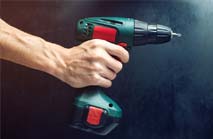ToolsInsuranceOnline History Lesson: The Power Drill
 Last year marked the 100th anniversary of the mighty power drill. One of the most iconic and must-have tools in any tool-users arsenal, the power drill has a hell of a history.
Last year marked the 100th anniversary of the mighty power drill. One of the most iconic and must-have tools in any tool-users arsenal, the power drill has a hell of a history.
The world’s first power drill currently sits on display in the National Museum of American History in Washington. As impressive as that is, Washington is a long way to go to learn about drills.
So we thought we’d save you the cost of the trip (you’re welcome) and give you all the juicy details of how the power drill came to be.
The beginning
Ever wonder why power drills look like space guns? That’s no coincidence. When Black + Decker first set up a humble machine shop in 1910, they were already thinking about making an electric drill. Specifically how it could be shaped to give the best performance and the best control. It just so happens one of their clients was gun manufacturer Colt. So when they saw a Colt handgun with its pistol and trigger, they had a lightbulb moment.
The middle
By 1917 they had a 12,000 sq foot manufacturing plant and they were busy making drills (among other things). The first drills were purely for industrial use since there was no home-improvement market to sell to. Plus not a lot of people had enough spare change for an industrial-strength power drill. Imagine getting tools insurance on that!
That all changed in the early 1920’s. Black + Decker started advertising a low-cost, portable power drill for non-professionals. After that they took some well-earned time off from drill sales to supply material to the allies during World War II. It wasn’t until a year after the war ended that Black + Decker came out with the first ever line of power tools for the home. The range had everything from ¼ inch and ½ inch drills to stands and accessories. Everything the post-war handyman could need!
But don’t go thinking that Black + Decker were the only company with the thrills for the drills. A.H Peterson released the Hole-Shooter portable drill a year after Black and Decker in 1924. When Peterson’s facility burned down the Milwaukee Electric Tool Co. took the product over. Bosch also joined the party in 1932 with electric drills and handheld rotary hammers.
The end?
No offence to Black + Decker, but Milwaukee has made some of the biggest waves in electric drills over the last two decades. In 2005 they introduced the lithium-ion battery-powered drill. This was a game-changer for how the drill was powered, what it could do, and what it looked like. Suddenly every tool company was raving about their battery power.
Last year, Milwaukee showcased their one-key smart tools. These drills remember settings for particular jobs, let you know how well they’re performing and tell you how to improve their performance. They also make a mean espresso – well not yet, but it’s only a matter of time!
So there you have it. Since the early days of Black + Decker the power drill has gone from strength to strength. Even though a lot has changed about it, every power drill you see still has that same pistol grip and trigger that makes the power drill so iconic. We can’t wait to see what happens next.